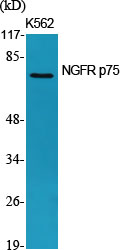Total NGFR p75 Cell-Based Colorimetric ELISA Kit
- Catalog No.:KA3529C
- Applications:ELISA
- Reactivity:Human;Mouse;Rat
- Gene Name:
- NGFR
- Human Gene Id:
- 4804
- Human Swiss Prot No:
- P08138
- Mouse Swiss Prot No:
- Q9Z0W1
- Rat Swiss Prot No:
- P07174
- Storage Stability:
- 2-8°C/6 months
- Other Name:
- Tumor necrosis factor receptor superfamily member 16 (Gp80-LNGFR) (Low affinity neurotrophin receptor p75NTR) (Low-affinity nerve growth factor receptor) (NGF receptor) (p75 ICD) (CD antigen CD271)
- Detection Method:
- Colorimetric
- Background:
- domain:Death domain is responsible for interaction with RANBP9.,domain:The extracellular domain is responsible for interaction with NTRK1.,function:Low affinity receptor which can bind to NGF, BDNF, NT-3, and NT-4. Can mediate cell survival as well as cell death of neural cells.,PTM:N- and O-glycosylated.,PTM:O-linked glycans consist of Gal(1-3)GalNAc core elongated by 1 or 2 NeuNAc.,PTM:Phosphorylated on serine residues.,similarity:Contains 1 death domain.,similarity:Contains 4 TNFR-Cys repeats.,subunit:Homodimer; disulfide-linked. Interacts with p75NTR-associated cell death executor. Interacts with TRAF2, TRAF4, TRAF6, PTPN13 and RANBP9. Interacts through TRAF6 with SQSTM1 which bridges NGFR to NTRK1. Interacts with BEX1 and NGFRAP1/BEX3. Interacts with KIDINS220 and NTRK1. Can form a ternary complex with NTRK1 and KIDINS220 and this complex is affected by the expression levels of KIDINS220. An increase in KIDINS220 expression leads to a decreased association of NGFR and NTRK1 (By similarity). Interacts with LINGO1.,
- Function:
- cell morphogenesis, cell morphogenesis involved in differentiation, hair follicle development, proteolysis, apoptosis,anti-apoptosis, induction of apoptosis, cell motion, ectoderm development, axonogenesis, axon guidance, cell death,positive regulation of cell proliferation, epidermis development, induction of apoptosis by extracellular signals,macromolecule catabolic process, response to temperature stimulus, detection of external stimulus, detection of abiotic stimulus, response to wounding, response to abiotic stimulus, negative regulation of signal transduction,negative regulation of cell communication, positive regulation of cell development, negative regulation of cell development, regulation of cell morphogenesis involved in differentiation, regulation of cell death, positive regulation of cell death, regulation of neuron projection development, programmed cell death, induction of
- Subcellular Location:
- Cell membrane ; Single-pass type I membrane protein . Perikaryon . Cell projection, growth cone . Cell projection, dendritic spine .
- June 19-2018
- WESTERN IMMUNOBLOTTING PROTOCOL
- June 19-2018
- IMMUNOHISTOCHEMISTRY-PARAFFIN PROTOCOL
- June 19-2018
- IMMUNOFLUORESCENCE PROTOCOL
- September 08-2020
- FLOW-CYTOMEYRT-PROTOCOL
- May 20-2022
- Cell-Based ELISA│解您多样本WB检测之困扰
- July 13-2018
- CELL-BASED-ELISA-PROTOCOL-FOR-ACETYL-PROTEIN
- July 13-2018
- CELL-BASED-ELISA-PROTOCOL-FOR-PHOSPHO-PROTEIN
- July 13-2018
- Antibody-FAQs


